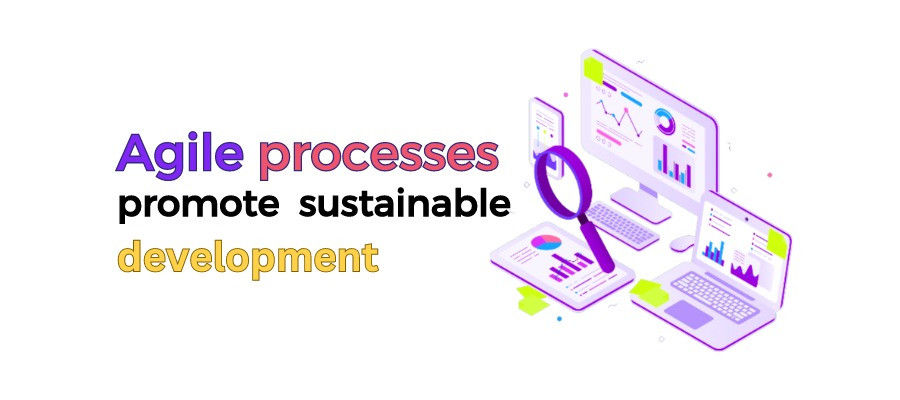Agile Principles Series – 8 of 12: Agile Processes Promote Sustainable Development

Have you ever heard about sustainable software development? While many of today's organizations are trying to achieve sustainability in software development, why is it necessary? The 8th Agile Principle from the Agile Manifesto emphasizes that:
“Agile processes promote sustainable development. The sponsors, developers, and users should be able to maintain a constant pace indefinitely.”
In our previous blog, we discussed delivering only working software. Today, we will explore the importance of sustainable development in the context of this Agile Principle. So, let’s begin with understanding the concept of sustainable development.
What Is Sustainable Development?
Sustainable development is more than maintaining the speed of development. Sustainable development is an Agile approach that supports the economic development of an organization without compromising product quality. The primary goal of Sustainability Development is:
- To minimize environmental impact as per the product development
- To meet the expected product quality based on end-user needs
As an Agile leader, your role drives the Agile Teams to deliver consistent value with sustainable development. You must strike a balance between the stakeholders and the Scrum Team to maintain quality output of goods and services.
Top Agile Processes To Deliver Development Sustainability:
Achieving development sustainability within Agile environments requires implementing proven processes that foster collaboration, adaptability, and continuous improvement. Here are some top Agile processes that organizations can leverage to promote sustainable development:
1. Scrum Framework
The Scrum framework is a cornerstone of Agile methodologies, emphasizing iterative progress and collaboration. Key roles within Scrum, such as the Scrum Master, Product Owner, and Developers, work collaboratively to deliver value in short, focused sprints. By adhering to Scrum principles, organizations can maintain a consistent pace, prioritize tasks effectively, and adapt to changing requirements swiftly.
2. User Stories and Product Backlog
User Stories and Product Backlog items (PBIs) provide a clear roadmap for Scrum Teams. Organizations can ensure that development efforts align with customer needs and organizational objectives by defining user-centric requirements and prioritizing them based on business value. Regular refinement sessions, conducted by the Product Owner, ensure the Product Backlog remains relevant and actionable.
3. Sprint Planning and Sprint Review
Effective Sprint Planning and Sprint Review sessions enable teams to set realistic goals, prioritize tasks, and evaluate progress collaboratively. By defining clear objectives for each Sprint and conducting regular reviews, organizations can maintain momentum, identify areas for improvement, and adapt their strategies based on feedback and performance metrics.
4. Continuous Integration and Deployment
Embracing continuous integration and deployment practices streamlines development workflows, reduces bottlenecks, and accelerates time-to-market. Organizations can ensure that changes are implemented seamlessly by automating testing, code integration, and deployment processes, minimizing disruptions, and enhancing product quality.
5. Cross-Functional Collaboration
Promoting cross-functional collaboration ensures that teams have access to diverse perspectives and expertise. Organizations can leverage collective insights, mitigate risks, and drive innovation by fostering communication and cooperation between developers, designers, product managers, and stakeholders.
Benefits of Promoting Sustainable Development:
Sustainable development is a core Agile principle. Balancing speed and quality of development is essential for Agile success. Let’s examine the advantages of following a sustainable development approach.
1. Improved Team Morale and Engagement
By focusing on sustainable development, Agile processes help improve team morale, engagement, and satisfaction. When team members feel valued, heard, and supported, they are more likely to remain committed to the project, collaborate effectively, and contribute to its success.
2. Enhanced Product Quality
Sustainable development emphasizes the importance of delivering high-quality products consistently. By maintaining a steady pace, incorporating continuous feedback, and prioritizing tasks effectively, Agile teams can focus on producing value-added features, reducing defects, and ensuring that the product meets customer expectations.
3. Faster Time-to-Market
Contrary to popular belief, promoting sustainable development does not slow the development process; it streamlines it. By avoiding the pitfalls of overcommitment, scope creep, and unrealistic deadlines, Agile processes enable teams to deliver products faster, respond to market changes more efficiently, and capitalize on emerging opportunities.
4. Long-Term Success and Adaptability
Sustainable development is not just about short-term gains but long-term success and adaptability. By fostering a continuous improvement, collaboration, and flexibility culture, Agile organizations can navigate challenges, seize opportunities, and remain competitive in today's rapidly evolving marketplace.
Let’s Rewind The 8th Agile Principle on Sustainable Development:
Agile processes promote sustainable development by emphasizing collaboration, adaptability, and continuous improvement. Whether you're an Agile beginner or an experienced Agile Practitioner, understanding these principles is essential. By embracing Agile methodologies, organizations can deliver value consistently while mitigating risks.
As we continue this series on Agile Principles, remember that Agile is more than a methodology; it's a mindset. Organizations prioritizing sustainability and collaboration are better positioned to thrive in today's fast-paced digital landscape.
Stay tuned for the next installment in our Agile Principles series, where we'll explore the ninth principle in detail. Embrace agility, foster collaboration, and lead your teams to success in the ever-evolving world of software development.
Reference:
https://medium.com/@arnabrajkhowa/agile-principle-8-d0f6cb7fb7b0



